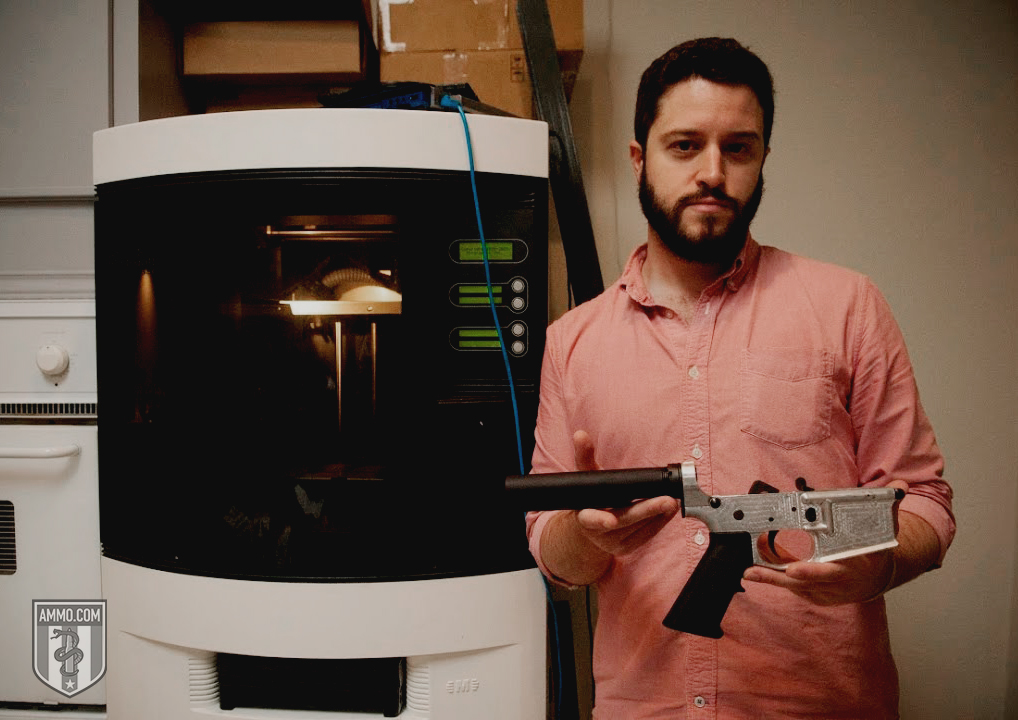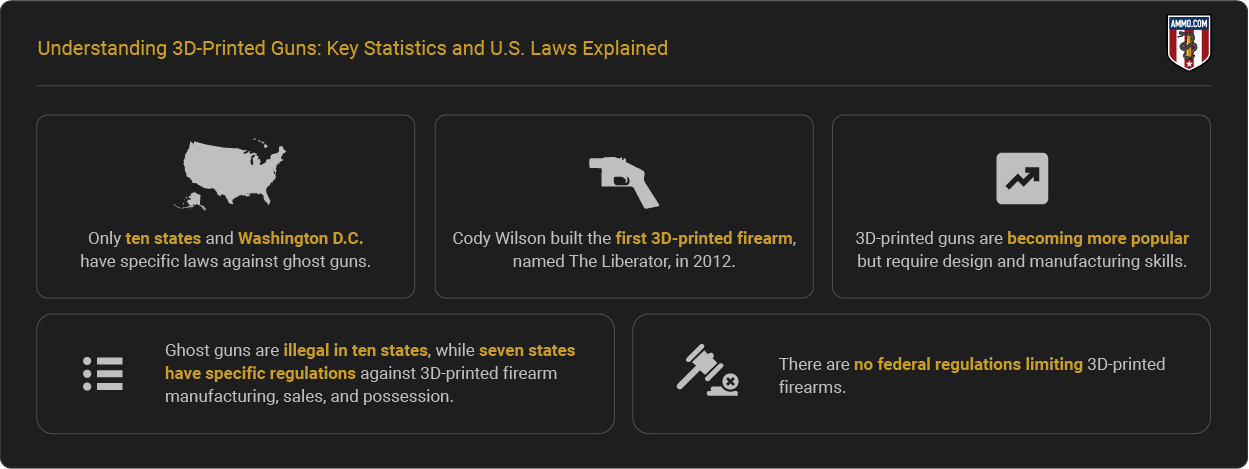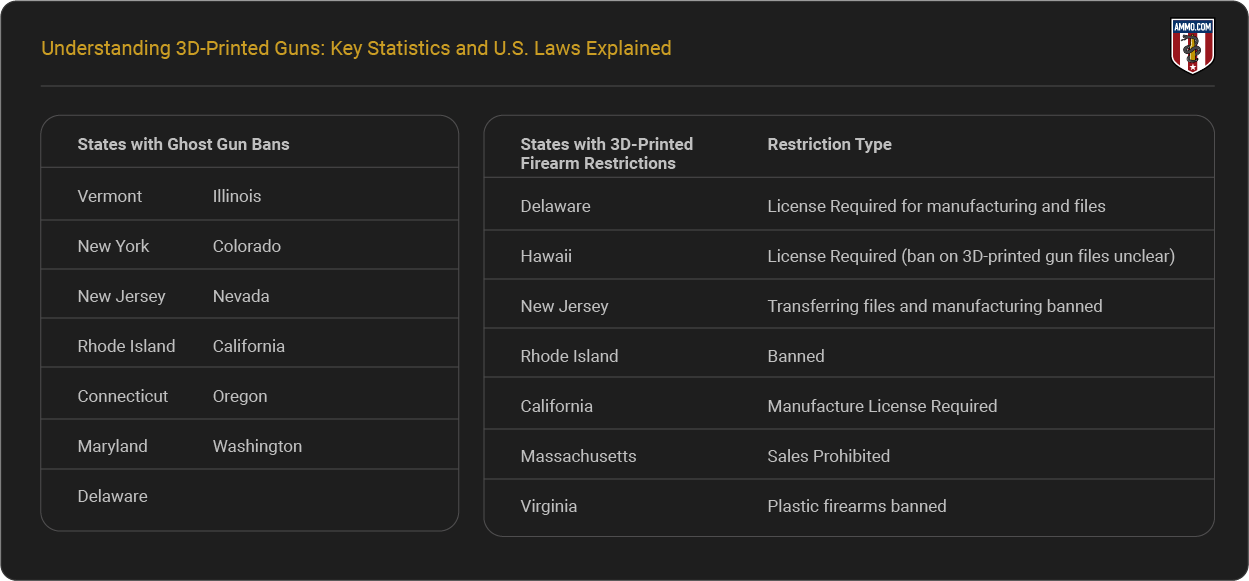3D-Printed Firearms and Defense Distributed: A Guide to Understanding Ghost Guns
You're free to republish or share any of our articles (either in part or in full), which are licensed under a Creative Commons Attribution 4.0 International License. Our only requirement is that you give Ammo.com appropriate credit by linking to the original article. Spread the word; knowledge is power!
 Disclaimer: This guide is intended to be informational only surrounding the topic of ghost guns and 3D-printed firearms. It is not legal advice.
Disclaimer: This guide is intended to be informational only surrounding the topic of ghost guns and 3D-printed firearms. It is not legal advice.
American ingenuity and technology may be the perfect solution to government overreach and unnecessary regulations.
In the 1920s and 1930s, people used modern technology (copper tubing and high-quality metals) to manufacture bootlegged alcohol. From the 1980s to the present, people have used various scientific advancements to make illegal drugs more potent and widely available.
Today, as ATF regulations aim to suppress and monitor Americans’ access to weapons, people are using 3D printers to manufacture firearms. Like moonshine and illegal drugs, these firearms are undetectable and nearly impossible to regulate.
As 3D-printed firearms and ghost guns flood headlines and legislation, you likely have many questions. Fortunately, we’re here to clear the air.
Only ten states and Washington D.C. have specific laws against ghost guns.
Cody Wilson built the first 3D-printed firearm, named The Liberator, in 2012.
3D-printed guns are becoming more popular but require design and manufacturing skills.
Ghost guns are illegal in ten states, while seven states have specific regulations against 3D-printed firearm manufacturing, sales, and possession.
There are no federal regulations limiting 3D-printed firearms.

Ammo.com strives to provide accurate and reliable information. You can verify our sources HERE.
What Are 3D Printed Firearms?
3D-printed firearms are privately manufactured using 3D printers and filaments. While they have yet to reach the reliability and effectiveness of commercially manufactured arms, they are interesting, serve a purpose, and are evolving.
Cody Wilson designed and manufactured the first known 3D-printed firearm in 2012. In 2013, he fired the first shot with his 3D-printed gun named The Liberator. 2
Although the media and politicians have raised concerns about 3D-printed guns, it is important to note that they require skill to make. From coding to understanding firearm mechanics, this isn’t something the average internet user can do without a lot of time and research.
What Are Ghost Guns?
Ghost guns, a term used to describe unserialized firearms, is a bit of a misnomer. For example, all guns in the U.S. were unserialized until the 1968 Gun Control Act. 1 This act forced manufacturers to serialize all firearms, and those that are unserialized today are considered ghost guns.
Although 3D-printed firearms fall under the scope of ghost guns, they are not the only firearms included. For example, 3D-printed guns have no serial number, but neither do those created from 80% lowers and other homemade firearms.
Furthermore, 3D-printed firearms are nearly impossible to track. Unlike other ghost guns, it’s possible to 3D print an AR receiver, for example. This minimizes the parts one must purchase and order to complete a firearm.
Do 3D Printed Firearms Work?
Early on, there was much debate about whether 3D-printed guns actually work. Despite evidence that they do, there are still skeptics in the community.
However, fully 3D-printed guns rarely work well. Most firearm builders need metal and pre-manufactured parts to obtain desirable results.
The components manufactured vary depending on the firearm. For example, a 3D-printed AR lower will work, whereas the frame and slide are printable parts on a Glock-style firearm.
What is the Purpose of 3D Printed Guns?
On May 13, 2024, Dexter Taylor was sentenced to 18 years in prison for manufacturing firearms in New York state. What’s worrisome about the conviction is that firearm parts manufacturers gave Taylor’s purchase history to the state of New York, prompting an investigation into this lifelong, non-violent, and law-abiding citizen’s private activities.
Although 3D-printed firearms have yet to reach the reliability and efficacy of pre-manufactured firearms, they appeal to gunsmiths and hobbyists as a means to circumvent unconstitutional monitoring of one’s private activities.
Contrary to popular belief, 3D-printed firearms are rarely used by criminals as there are much easier ways to obtain firearms illegally. They require skill and knowledge to manufacture, which many criminals likely lack.
The Legality of 3D Printed Firearms
The legality of 3D-printed firearms in the U.S. is a convoluted and often confusing topic. Only ten states and Washington D.C. have specific laws against ghost guns, including 3D-printed firearms.
Here, we’ll review the federal and local regulations for printing firearms. However, it’s important to note that legislation changes frequently and may be broader than we can cover in one article.
Federal Firearm Regulations & 3D Printing
There are no federal laws that prohibit individuals from manufacturing privately owned firearms. In the case of Dexter Taylor, the ATF stated that Taylor violated no federal laws.
However, there are laws surrounding which firearms you can manufacture. For example, the 1986 FOPA limits the type of firearm you can legally build. Due to the 1988 Undetectable Firearms Act, your creations must also contain enough metal to be detected by standard metal detectors.
Moreover, the ATF has rules and regulations regarding which firearm components you can privately manufacture. From auto seers to what the ATF considers a receiver, it’s best to check federal regulations before manufacturing parts and firearms. 3

1, 12, 13, 14
State Firearm Regulations & 3D Printing
Only ten states and Washington D.C. have regulations against ghost guns. Furthermore, some states have specific rules against 3D-printed firearms. Therefore, reviewing your state’s laws before downloading files or printing firearm components is essential.
To further compound the issue of legality, many state-level laws regarding 3D-printed guns are pending in courts at the time of this writing, and some, like Virginia’s, are generally considered unclear.
For example, § 18.2-308.5 in the Virginia code prohibits the possession of plastic firearms. However, most 3D-printed firearms contain some metal.

4, 5, 6, 7, 8
The Constitutionality of 3D-Printed Firearms
The first well-known case challenging the government’s overreach regarding 3D-printed guns wasn’t a Second Amendment case but a First Amendment case.
In 2013, Cody Wilson’s non-profit organization, Defense Distributed, published the plans for the Liberator as an open-source file that anyone could download or modify. After more than 100,000 downloads in two days, the Department of Defense requested that the files be removed as they were violating arms trafficking laws.
Cody Wilson and Defense Distributed took the Department of Defense to court in 2016, citing the First Amendment as the files are protected under free speech. Unfortunately, the courts were not receptive to this argument, and Defense Distributed is still barred from sharing the files online. 15
Ghost guns have become a focal point for the gun control lobby, but the issue is often over-politicized, failing to reflect the full reality of unserialized firearms in the U.S. According to the Justice Department, more than 23,000 unserialized firearms, commonly referred to as "ghost guns," were seized by law enforcement between 2016 and 2020. This number includes firearms connected to various crimes, including over 300 homicides or attempted homicides. 16
From 2017 to 2021, the ATF traced 37,980 privately manufactured firearms (PMFs) that were potentially linked to criminal activities. However, it’s important to note that a trace request by law enforcement does not necessarily mean these firearms were used in crimes. In fact, these PMFs accounted for only 2% of all firearms traced by the ATF during this period, highlighting their relatively small footprint in the broader context of crime guns. 17
How Many Ghost Gun Murders Have Happened Throughout the Years?
Between 2016 and 2020, only 325 homicides or attempted homicides were linked to unserialized ghost guns 16. In comparison, over 8,000 people were stabbed, and 7,000 murders were caused by unspecified objects. Additionally, suffocation and beatings accounted for 4,799 murders, poisonings for 888, and fire for 748.
It’s important to note that more people were killed by fire than by ghost guns during this period 17.
How Many 3D-Printed Gun Arrests Have Occurred?
Tracking the number of arrests related to 3D-printed and privately manufactured firearms (PMFs) is challenging, as these firearms are not illegal nationwide. However, prosecutions are becoming increasingly common in states with anti-PMF laws.
For instance, in 2023, twenty-nine individuals in San Diego were arrested for manufacturing eighty-two firearms, among other crimes 21. In New York City, Lenold Caesar and Dexter Taylor were arrested within the past two years for privately manufacturing firearms, with 359 ghost guns being confiscated by the police during that time.
Additionally, a New York father was indicted in May 2024 for manufacturing ghost guns in his apartment 20.
While the exact number of arrests is unknown, district attorneys and attorneys general across the country are increasingly prosecuting civilians for privately manufacturing firearms, including 3D-printed guns.
Since 1980, ghost guns have been used in only two out of 106 mass shootings 22.
The first incident occurred in Sacramento, CA, in February 2022, where a shooter used a homemade semiautomatic rifle and an illegal 30-round magazine, resulting in four deaths.
The second incident took place in Colorado Springs, CO, in November 2022, where a shooter killed five and wounded 18. The shooter used an AR-15-style rifle and a handgun, both classified as ghost guns, along with a 60-round drum and several 40-round magazines.
Based on this information, handmade or unserialized firearms were involved in only 1.9% of mass shootings in public settings where a firearm was used.
How Many Ghost Guns Are Used in School Shootings?
Ghost guns are rarely involved in school shootings. In fact, there have only been four reported incidents where a ghost gun was recovered on or near school grounds during the commission of any crime 21.
Given the hundreds of firearm-related incidents that occur on or near school campuses, the concern over ghost guns in these settings appears to be over-politicized.
Are 3D Printed Guns Safe?
An important rule to live by is that any object is only as safe as the user. Quality control, skill, and knowledge are critical to safely building and operating a 3D-printed firearm.
Naturally, there are risks to launching a projectile at 1,200 fps out of a barrel. However, these risks are easily mitigated with proper analysis and technique. For example, 3D-printed files can be manipulated. If you don’t know what flaws to look for and how to code your own designs, your firearm will quickly fail, which can be dangerous.
Essentially, 3D-printed firearms can be safe, but it’s up to the user to ensure their own safety.
Cryptocurrency and 3D-Printing Firearms
Crypto, similar to 3D-printing firearms, is another tool to circumvent government regulation and overreach. Internationally, gangs use Bitcoin to procure firearms from abroad. A Michigan man was arrested for acquiring illegal firearms using cryptocurrency in 2015.
As the U.S. government strains to enact stricter gun control measures, cryptocurrency emerges as a pathway for nefarious individuals to sidestep state and federal firearms regulation. Crypto offers anonymity regarding ghost gun purchases, making it challenging for authorities to trace purchases and enforce laws. (22,, 23)
American Ingenuity Meets Technology
3D-printed firearms open many new doors. Some of these doors lead to liberty, while others lead to more government regulations and infringements on American citizens' Second Amendment rights.
Despite claims from the media and anti-2A politicians, 3D-printed firearms do require skill to manufacture, and there are much easier ways to obtain more effective firearms. However, the future of 3D-printed gun technology is bright for hobbyists and manufacturers looking forward to building privately made firearms.
Sources
- The 1968 Gun Control Act (Interstate Commerce)
- The Liberator - the world’s first 3D-printed handgun
- Manufacturing NFA Firearms
- Delaware Ghost Gun Ban on Hold
- Virginia Plastic Gun Laws
- Massachusetts 3D-Printed Guns Notice
- 3D-Printing Guns Require License in California
- Ghost Guns Ban Signed into Law Rhode Island
- Understanding New Jersey’s Gun Laws
- Hawaii Gun Laws - ATF
- Delaware HB 125
- 1986 FOPA
- 1988 Undetectable Firearms Act
- ATF Privately Made Firearms
- Texas State Law Library: 3D-Printed Firearms
- Numbers Undercut Biden Administration Claims on Ghost Guns
- 1999-2020 Underlying Cause of Death by Bridged-Race Categories: CDC Wonder Database
- Crime Guns Recovered and Traced Within the United States and Its Territories
- Man Indicted for Manufacturing Ghost Guns in Harlem Apartment
- Three Month Campaign to Reduce Violent Crime: ATF
- ‘Ghost guns’ showing up in school shootings, experts fear trend will get worse
Gun Rights
- Federal Gun Control in America: A Historic Guide to Major Federal Gun Control Laws and Acts
- State Gun Control in America: A Historic Guide to Major State Gun Control Laws and Acts
- The Supreme Court and the Second Amendment: Understanding the Court's Landmark Decisions
- Early American Militias: The Forgotten History of Freedmen Militias from 1776 until the Civil War
- American Militias after the Civil War: From Black Codes to the Black Panthers and Beyond
- Negroes With Guns: The Untold History of Black NRA Gun Clubs and the Civil Rights Movement
- American Gun Ownership: The Positive Impacts of Law-Abiding Citizens Owning Firearms
- 3D-Printed Firearms and Defense Distributed: A Guide to Understanding "Ghost Guns"
- Commercial Ammo: The Untold History of Springfield Armory and America's Munitions Factories
- Gun Background Checks: How the State Came To Decide Who Can and Cannot Buy a Firearm
- The American Old West: How Hollywood Made It “Wild” to Make Money & Advance Gun Control
- Prescription For Violence: The Corresponding Rise of Antidepressants, SSRIs & Mass Shootings
- If It Bleeds It Leads: How the American Media Perpetuates and Profits from Mass Shootings
- Deplatformed: How Big Tech and Corporate America Help Subvert the 1st and 2nd Amendments
- History of the ATF: How the Bureau of Alcohol, Tobacco & Firearms Became Corrupt & Abusive
- Joe Biden on Gun Control: Understanding Biden's 2020 Platform and the Second Amendment
- Gun Control and Racism: The Laws and Taxes Meant to Limit Minority Gun Ownership in America
- Protection or Pain Treatment: Choosing Between Your Gun and Medical Marijuana
- Gunsmithing: How to Make Money From Your Firearm Knowledge and Tools
- Collectible Weapons: How to Protect Your Wealth – and Your Family – With Valuable Guns
- How to Build a Gun Club: A Guide to Organizing and Starting Your Own Local Gun Club
- Are Hollow Points Illegal? Understanding When & Where You Can Use HP Bullets
